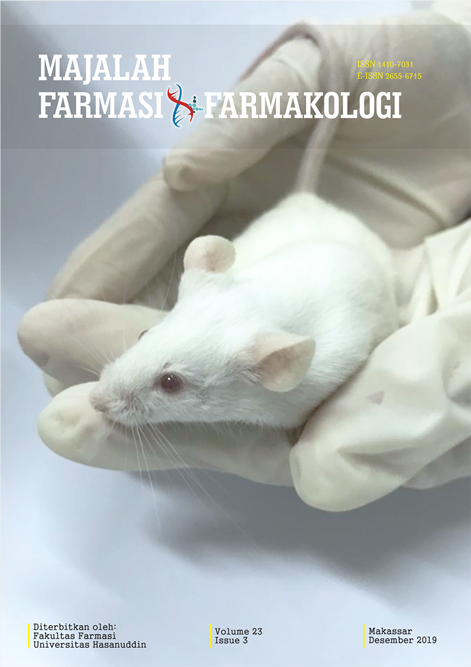EVALUASI HEMATOTOKSIK SECARA IN VITRO NANOPARTIKEL ZnS HASIL REDUKSI BIOMATRIKS Eschericia coli
Article History
Submited : February 16, 2020
Published : February 16, 2020
Nanopartikel ZnS merupakan material semi konduktor yang memiliki sifat unik dan manfaat yang besar dibidang kesehatan, terutama sebagai antibakteri dan biomarker kanker. Walaupun demikian, informasi mengenai toksisitas dari nanopartikel ZnS masih sangat terbatas. Oleh karena itu, pada penelitian ini telah dilakukan evaluasi hematotoksisitas secara in vitro nanopartikel ZnS hasil reduksi biomatriks Escherichia coli. Penyiapan nanopartikel ZnS diawali dengan pencampuran dispersi ZnSO4 konsentrasi 200 bpj ke dalam medium Luria Bertani Broth (LBB) yang ditumbuhi E.Coli sebagai bioreduktor. Produk yang dihasilkan dikarakterisasi dengan uji photolimunisence (PL) dan spektrofotometri pada rentang panjang gelombang 250-700 nm. Hasilnya, nanopartikel ZnS berpendar biru dan diidentifikasi pada λmax 288 nm dengan absorbansi 0,905. Partikel yang dihasilkan kemudian didispersikan dengan variasi volume 30 µl, 40 µl, 50 µl pada larutan tyrod. Data persentase hemolisis secara berturut-turut adalah 32%, 39%, 22%, 0% (kontrol negatif) dan 100% (kontrol positif). Sehingga dapat disimpulkan bahwa nanopartikel ZnS hasil reduksi E.coli memberikan efek toksik terhadap sel darah merah
References
- Asha, P., Rajeswari, M. and Bindhu, B. 2016. Zinc sulfide nanoparticles : processing , properties and applications : an overview, Journal of Chemcal and Pharmaceutical Sciences, 9(4), pp. 2047–2052.
- Amily Fang-ju jou. dkk. 2015. Diagnosing the mir-141 prostate cancer biomarker using nucleic acid-functiolized cdSe/ZnS Qds and telomerase. Chemical science. 659-665
- Sathishkumar, M. et al. 2017. characterization Antimicrobial activity of zinc sulphide nanoparticles and to study their characterization. Reasearch Gate
- Durán, N. and Seabra, A. B. 2012. Microbial Syntheses of Metallic Sulfide Nanoparticles : An Overview’, Current Biotechnology, Volume 1 (Juni 2015), pp. 287–296. doi: 10.2174/2211550111201040287.
- Dirgantarah, W. 2017. Studi Aplikasi Biomatriks Bakteri Escherichia Coli Pada Produksi Quantum Dots Zink' Skrpsi tidak diterbitkan. Makassar. Fakultas Farmasi Unhas.
- Jackson, T. C., Patani, B. O. and Israel, M. B. 2017. Nanomaterials and Cell Interactions : A Review’, Journal of Biomaterials and nanobiotechnology, pp. 220–228. doi: 10.4236/jbnb.2017.84015.
- Helle, M. et al. (2012) ‘Visualisation of Sentinel Lymph Node with Indium-Based near Infrared Emitting Quantum Dots in a Murine Metastatic Breast Cancer Model’, PLoS ONE, 7(8). doi: 10.1371/journal.pone.0044433.
- Bogutska, К. І., Sklyarov, Y. P. and Prylutskyy, Y. І. 2013 .Zinc and zinc nanoparticles : biological role and application in biomedicine. Ucranica Bioorganica 9–16.
- Rijas-Hernandez dkk. 2017. ZnS nanoparticles syhmtesised through chemical aggregation using polyetieneimene that works as boyh stabilizser and complexing agent.
Kurniati, L., Arjuna, A., & Mamada, S. S. (2020). EVALUASI HEMATOTOKSIK SECARA IN VITRO NANOPARTIKEL ZnS HASIL REDUKSI BIOMATRIKS Eschericia coli. Majalah Farmasi Dan Farmakologi, 23(3), 82-84. https://doi.org/10.20956/mff.v23i3.9398
Downloads
Download data is not yet available.
Fulltext
